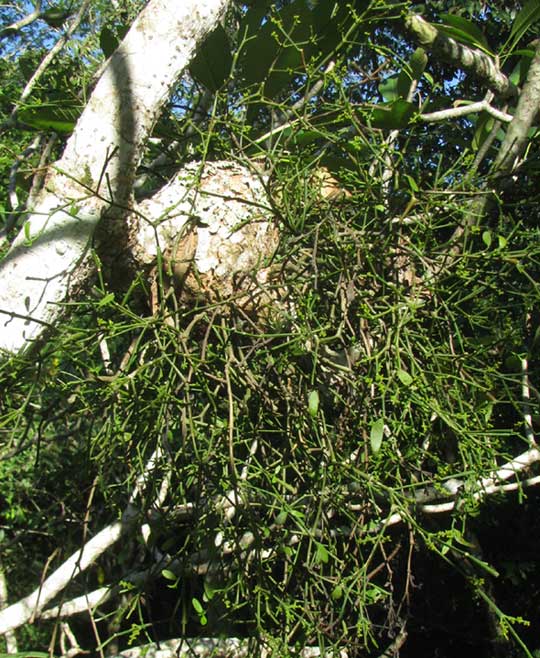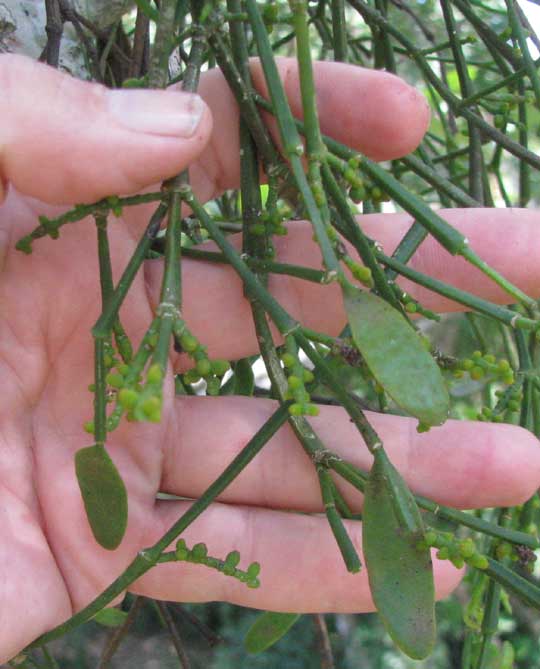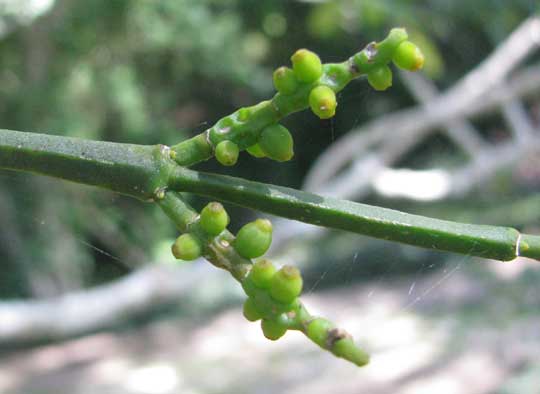Excerpts from Jim Conrad's
Naturalist Newsletter
from the November 27, 2011 Newsletter issued from Hacienda Chichen Resort beside Chichén Itzá Ruins; limestone bedrock; elevation ~39m (~128ft), N20.675°, W88.569°; central Yucatán state, MÉXICO
NEEDLETIPPED MISTLETOE
Here in the past we've run into species of "tropical mistletoes" with surprisingly large, red flowers, as well as one with tiny flowers, thus very much like the North's mistletoe -- except that it was much bigger, hippopotamus-size. Here at the Hacienda there's a second North-America-type mistletoe, an unusual one because its stems are squared. You can see a cluster, mostly leafless now at the start of the dry season, below:

In that picture, notice that the part of the host tree's limb (It's a Frangipani) from which the mistletoe's stems emerge is abnormally swollen. The tree bore several such colonies and wherever mistletoe stems arose there was considerable swelling. Though several Frangipanis grew in the immediate area, only this one tree bore mistletoe.
A shot better showing the Mistletoe's leaves and fruit is below:

Here's a close-up highlighting the squared stems:

This is PHORADENDRON MUCRONATUM, sometimes referred to in English as Needletip Mistletoe, the needletip referring to the tiny, sharp but very short, single spines at the tips of some leaves. The species occurs from southern Mexico through Central America into tropical South America.
Mistletoes are "semi-parasitic" on trees; only "semi" because possessing their own green leaves and stems they photosynthesize carbohydrates for themselves, robbing from the host tree only water and nutrients.
While looking for information on this species I ran into the online "Biblioteca Digital de La Medicina Tradicional Mexicana" (Digital Library of Traditional Mexican Medicine). It claims that an important traditional medicinal use of the closely related Phoradendron quadrangulare in Mexico is for the treatment of Herpes zoster, better known as shingles. Shingles is a painful, blistering skin rash caused by the same virus that causes chickenpox. You apply to the sores a powder from the mistletoe's ground-up leaf, then atop this secure an entire leaf with a bandage.
The page also says that the same treatment can relieve general muscle pain. My friend José the shaman has told me the same about local mistletoes he knows.
The above-mentioned "Biblioteca Digital" is great to browse through if you read Spanish. It's at http://www.medicinatradicionalmexicana.unam.mx/index.php.
The search window at that address doesn't function on my computer but you can find plants for which there's information -- and there's a lot of them -- by looking for them alphabetically using the Índice Alfabético.